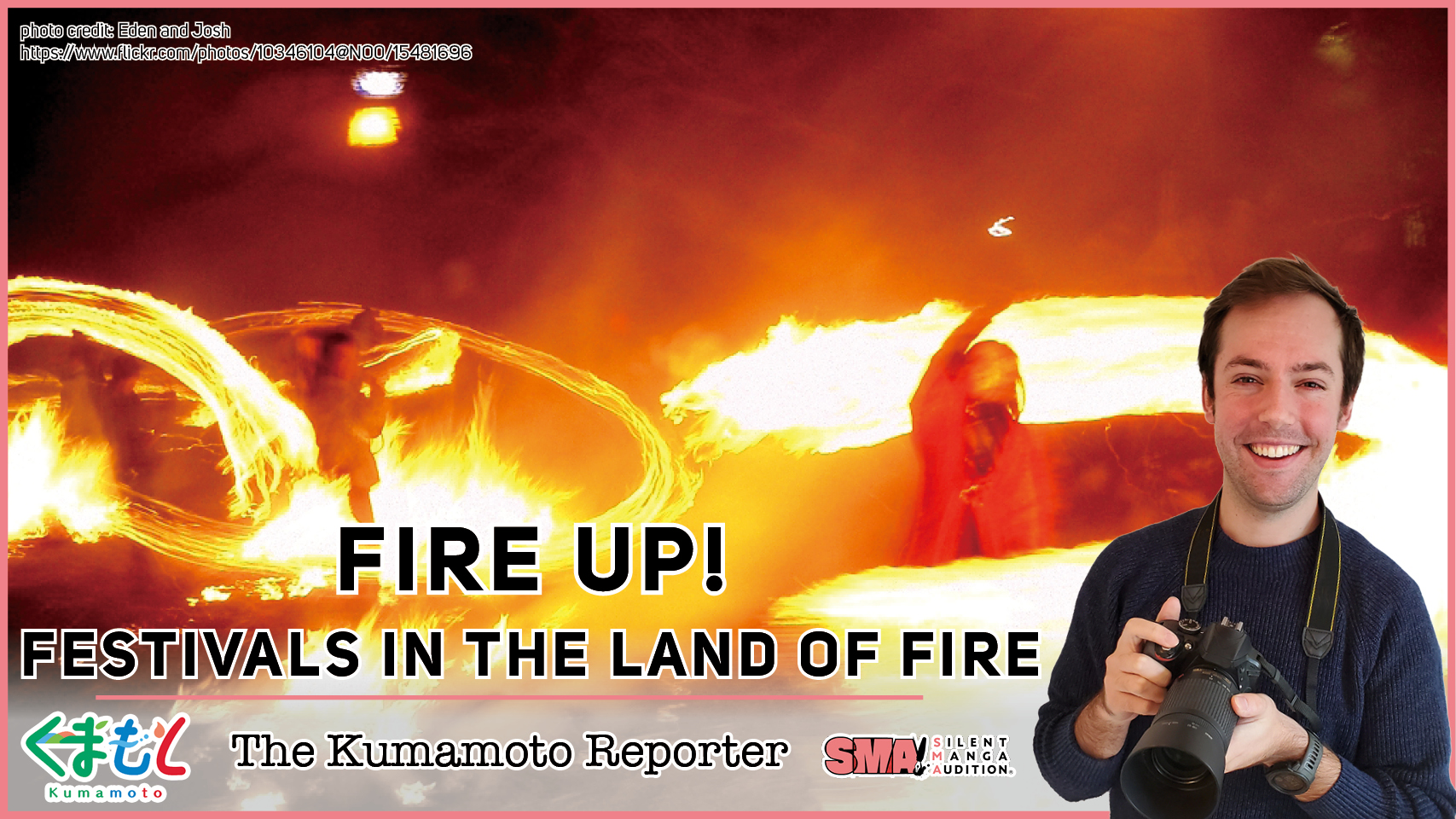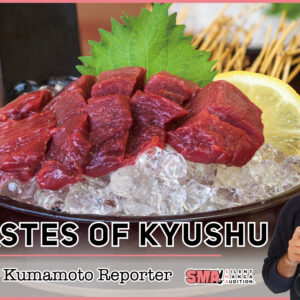
The Kumamoto Reporter #06 – Fire Up! Festivals in the Land of Fire
09/03/2022
8 min read
Hey SMA community! Last time we learned about Kumamoto Castle and its importance to both Kumamoto Prefecture and the Artists Village Aso 096k. This time we’ll learn even more about Kumamoto Prefecture by looking at an important part of its culture: festivals! Grab your friends and throw on some festival gear, it’s time to party!
Aso Fire Festival
Just a short drive from our Artists Village lies Aso Shrine, the oldest shrine in Kumamoto. If you happen to visit the shrine in March and are feeling adventurous, you can try your hand at swinging around a flaming hale bale on a string (seriously!). All playing with fire aside, the Aso Fire Festival’s purpose is to pray for a successful harvest and to celebrate the marriage of two gods that reside in the shrine. If your hunger for fire isn’t satisfied by swinging around the flaming hay bale like a wild person, you can see the controlled burning of Aso’s great swathes of silver grass just a few weeks before the festival.
Ushibuka Haiya Festival
On the opposite side of the spectrum is the Ushibuka Haiya Festival in Amakusa, known for its pristine beaches and sublime seafood. Located in the most southern part of the island, Ushibuka was a bustling port town in the Edo Period (1603-1867) and an important point for passing ships and fishermen due to the southern winds that were needed for their boats to sail north. It was these southern winds, called “hae no kaze” during those times that led local women singing to entertain sailors taking refuge from storms and waiting for favorable “hae no kaze.” Today, approximately 3,000 people dance through the streets of Ushibuka each year in April singing the same song that was sung over 200 years ago.
 Koinobori Festival
Speaking of fish, if you visit the small hot spring town of Tsuetate Onsen in May you’ll witness an incredible sight of over 3,500 koi (carp) streamers strung over the river that flows through the town. The festival celebrates the May 5th holiday of Children’s Day, and has significant importance for young boys. The streamers are a symbol of courage and strength, since carp are known for their ability to swim against the river current and even up waterfalls.
Koinobori Festival
Speaking of fish, if you visit the small hot spring town of Tsuetate Onsen in May you’ll witness an incredible sight of over 3,500 koi (carp) streamers strung over the river that flows through the town. The festival celebrates the May 5th holiday of Children’s Day, and has significant importance for young boys. The streamers are a symbol of courage and strength, since carp are known for their ability to swim against the river current and even up waterfalls.
 Tamana Iris Festival
Rivers and ponds are vital for both people and animals, as well as for the beautiful iris flowers! Every year people gather far and wide to enjoy the dazzling display of colors from the wide variety of irises that bloom in Tamana City in northern Kumamoto. Usually they bloom near the end of May, right before the rainy season starts in Kyushu. During your visit, don’t miss out on Tamana’s famous ramen and onsens!
Yamaga Lantern Festival
Near Tamana lies Yamaga, famous for onsen, the Yachiyoza Theater, and its thousand lantern dance. On the nights of August 15th and 16th 1,000 women gather dressed in white yukata (summer kimono) and wearing carefully crafted paper lanterns on their heads to participate in the festival. The festival can trace its beginnings to an ancient legend which tells of how the Yamaga villagers came to the aid of Emperor Keiko (71 to 130 AD) and his followers by leading them with pine torches through a thick fog.
Mizuakari Festival
If dancing with a lantern on top of your head isn’t your thing, swing by Kumamoto City for a spectacular light up display! Over 54,000 candles and 3,500 bamboo shoots are lit and placed around Kumamoto Castle, making for a few magical nights in October. 5,000 lanterns are also lit and set afloat along the Tsuboi river, or the moat of Kumamoto Castle.
Hinokuni Festival
The last festival on this list is one that your very own Kumamoto Reporter participated in! Long lines of food stalls and games lead up to Kumamoto Castle during the festival, but the main event of the festival is the free-for-all Otemoyan Dance. During the dance, the streets are closed off and the participants dance and sing the famous Kumamoto folk song “Otemoyan” which was made about 80 years ago. If you’re lucky, during the festival you may even spot one of the most popular Prefectural mascots in Japan: Kumamon!
Tamana Iris Festival
Rivers and ponds are vital for both people and animals, as well as for the beautiful iris flowers! Every year people gather far and wide to enjoy the dazzling display of colors from the wide variety of irises that bloom in Tamana City in northern Kumamoto. Usually they bloom near the end of May, right before the rainy season starts in Kyushu. During your visit, don’t miss out on Tamana’s famous ramen and onsens!
Yamaga Lantern Festival
Near Tamana lies Yamaga, famous for onsen, the Yachiyoza Theater, and its thousand lantern dance. On the nights of August 15th and 16th 1,000 women gather dressed in white yukata (summer kimono) and wearing carefully crafted paper lanterns on their heads to participate in the festival. The festival can trace its beginnings to an ancient legend which tells of how the Yamaga villagers came to the aid of Emperor Keiko (71 to 130 AD) and his followers by leading them with pine torches through a thick fog.
Mizuakari Festival
If dancing with a lantern on top of your head isn’t your thing, swing by Kumamoto City for a spectacular light up display! Over 54,000 candles and 3,500 bamboo shoots are lit and placed around Kumamoto Castle, making for a few magical nights in October. 5,000 lanterns are also lit and set afloat along the Tsuboi river, or the moat of Kumamoto Castle.
Hinokuni Festival
The last festival on this list is one that your very own Kumamoto Reporter participated in! Long lines of food stalls and games lead up to Kumamoto Castle during the festival, but the main event of the festival is the free-for-all Otemoyan Dance. During the dance, the streets are closed off and the participants dance and sing the famous Kumamoto folk song “Otemoyan” which was made about 80 years ago. If you’re lucky, during the festival you may even spot one of the most popular Prefectural mascots in Japan: Kumamon!
 Next time on the Kumamoto Reporter we’ll dive even further into Kumamoto’s culture by taking a look at its legends and “Yokai,” or Japanese spirits! In the meantime, if you’d like to learn about the legend of the true Kabuki-mono, a man always with the festival spirit, check out the latest article from the Artists Village Insider about “Keiji’s Kabuki Adventure!”
Next time on the Kumamoto Reporter we’ll dive even further into Kumamoto’s culture by taking a look at its legends and “Yokai,” or Japanese spirits! In the meantime, if you’d like to learn about the legend of the true Kabuki-mono, a man always with the festival spirit, check out the latest article from the Artists Village Insider about “Keiji’s Kabuki Adventure!”

 Koinobori Festival
Speaking of fish, if you visit the small hot spring town of Tsuetate Onsen in May you’ll witness an incredible sight of over 3,500 koi (carp) streamers strung over the river that flows through the town. The festival celebrates the May 5th holiday of Children’s Day, and has significant importance for young boys. The streamers are a symbol of courage and strength, since carp are known for their ability to swim against the river current and even up waterfalls.
Koinobori Festival
Speaking of fish, if you visit the small hot spring town of Tsuetate Onsen in May you’ll witness an incredible sight of over 3,500 koi (carp) streamers strung over the river that flows through the town. The festival celebrates the May 5th holiday of Children’s Day, and has significant importance for young boys. The streamers are a symbol of courage and strength, since carp are known for their ability to swim against the river current and even up waterfalls.
 Tamana Iris Festival
Rivers and ponds are vital for both people and animals, as well as for the beautiful iris flowers! Every year people gather far and wide to enjoy the dazzling display of colors from the wide variety of irises that bloom in Tamana City in northern Kumamoto. Usually they bloom near the end of May, right before the rainy season starts in Kyushu. During your visit, don’t miss out on Tamana’s famous ramen and onsens!
Tamana Iris Festival
Rivers and ponds are vital for both people and animals, as well as for the beautiful iris flowers! Every year people gather far and wide to enjoy the dazzling display of colors from the wide variety of irises that bloom in Tamana City in northern Kumamoto. Usually they bloom near the end of May, right before the rainy season starts in Kyushu. During your visit, don’t miss out on Tamana’s famous ramen and onsens!
 Next time on the Kumamoto Reporter we’ll dive even further into Kumamoto’s culture by taking a look at its legends and “Yokai,” or Japanese spirits! In the meantime, if you’d like to learn about the legend of the true Kabuki-mono, a man always with the festival spirit, check out the latest article from the Artists Village Insider about “Keiji’s Kabuki Adventure!”
Next time on the Kumamoto Reporter we’ll dive even further into Kumamoto’s culture by taking a look at its legends and “Yokai,” or Japanese spirits! In the meantime, if you’d like to learn about the legend of the true Kabuki-mono, a man always with the festival spirit, check out the latest article from the Artists Village Insider about “Keiji’s Kabuki Adventure!”




























